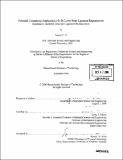Potential commercial application of a bi-layer bone-ligament regeneration scaffold to anterior cruciate ligament replacement
Author(s)
Li, Jessica C. (Jessica Ching-Yi)
DownloadFull printable version (23.53Mb)
Other Contributors
Massachusetts Institute of Technology. Dept. of Materials Science and Engineering.
Advisor
Lorna J. Gibson.
Terms of use
Metadata
Show full item recordAbstract
A business model was created in order to explore the commercial application of a bi-layer bone-ligament scaffold to the treatment of torn anterior cruciate ligaments (ACL) requiring replacement. The two main keys in producing the bone scaffold are triple co-precipitation of type-I collagen, chodroitin-6-sulphate, and calcium phosphate minerals and the use of lyophilization to create a network where all the materials are homogeneously dispersed and present in significant amounts. This process allows the creation of a porous network whose physical characteristics, mechanical properties, and material content can all be changed to create a scaffold that closely mimics natural bone. A collagen and chondroitin-6-sulphate scaffold is used for ligament regeneration. The ACL replacement market was chosen because it is one of the most commonly surgically repaired ligaments in the body and because all of the current treatments have drawbacks. (cont.) The exercise of creating a business model made it clear that the commercial potential of starting a company that focused on marketing a direct ACL replacement scaffold would most likely not be successful mainly because surgeons would hesitate to use this product over current methods that are satisfactory and it would be difficult to separate our product from other newer methods which all boast similar advantages over current treatment options. However, the commercial potential of using the technology to create a scaffold for graft site morbidity in certain ACL replacement surgeries is large because there is no competition, and the implantation procedure for the surgeon would be simple.
Description
Thesis (M. Eng.)--Massachusetts Institute of Technology, Dept. of Materials Science and Engineering, 2006. Includes bibliographical references (p. 71-74).
Date issued
2006Department
Massachusetts Institute of Technology. Department of Materials Science and EngineeringPublisher
Massachusetts Institute of Technology
Keywords
Materials Science and Engineering.